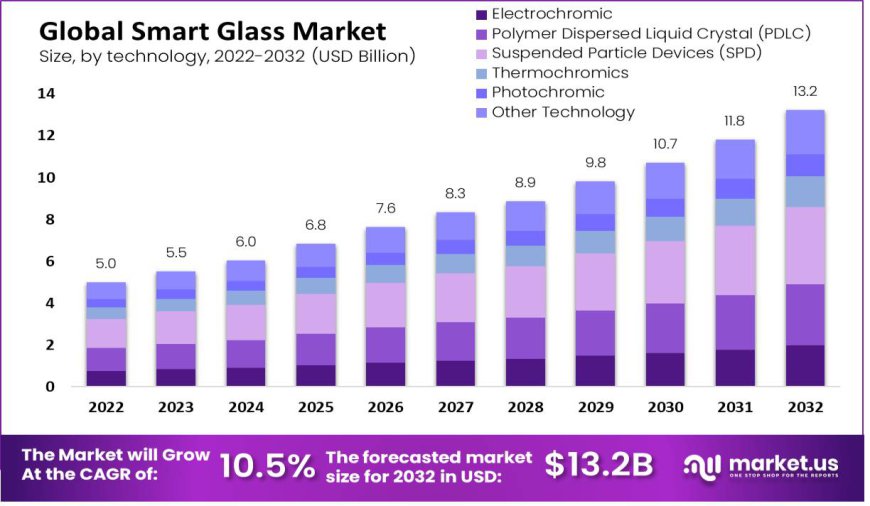Smart Glass Market: The Transparent Future of Smart Tech
The Global Smart Glass Market size was valued at USD 5.5 billion in 2023 and is expected to grow at a CAGR of 10.5% and reach USD 13.2 billion during the forecast period of 2023-2032.
Introduction
The smart glass market is evolving rapidly, driven by advancements in technology and increasing consumer interest. Growth factors include the rising demand for energy-efficient solutions, technological innovations in glass materials, and the expansion of the smart home and automotive sectors.
Read More - https://market.us/report/smart-glass-market/
However, the market faces challenges such as high production costs and limited consumer awareness. For new entrants, opportunities abound in leveraging cutting-edge technologies, exploring niche applications, and forming strategic partnerships to drive market penetration and growth.
Emerging Trends
- Advanced Tinting Technologies: Smart glass technology is incorporating sophisticated tinting mechanisms, such as electrochromic and photochromic materials, to offer more control over light and heat.
- Integration with IoT: The integration of smart glass with Internet of Things (IoT) devices is becoming more prevalent, enhancing automation and user control.
- Sustainability Focus: Increasing emphasis on eco-friendly and energy-efficient solutions is driving the development of smart glass products that reduce energy consumption.
- Automotive Applications: There is a growing adoption of smart glass in vehicles, offering features like adjustable tinting for better driver comfort and safety.
- Architectural Innovation: Architects and designers are increasingly incorporating smart glass in buildings to enhance aesthetics and functionality, including dynamic facades and interior partitions.
Top Use Cases
- Energy Efficiency: Smart glass helps in reducing energy costs by controlling heat and light transmission, making buildings more energy-efficient.
- Privacy Control: In both residential and commercial settings, smart glass can switch from clear to opaque to provide privacy on demand.
- Automotive Industry: Used in vehicles for adjustable tinting, smart glass improves comfort and visibility while enhancing vehicle aesthetics.
- Healthcare Facilities: Smart glass is used in hospitals and clinics to create privacy for patients and control ambient lighting.
- Retail Environments: Retailers use smart glass for dynamic displays and to manage lighting and ambiance, enhancing the shopping experience.
Major Challenges
- High Production Costs: The cost of manufacturing smart glass remains relatively high, which can limit market accessibility for some consumers and businesses.
- Limited Consumer Awareness: Many potential users are not fully aware of the benefits and applications of smart glass, impacting market adoption.
- Technology Integration Issues: Integrating smart glass with existing systems and technologies can be complex and may require significant adaptation.
- Durability Concerns: Ensuring the long-term durability and reliability of smart glass products in various environments can be challenging.
- Regulatory Hurdles: Compliance with regulations and standards across different regions can be a barrier for market entry and expansion.
Market Opportunity
- Growing Demand for Energy-Efficient Solutions: As global awareness of energy conservation increases, there is a growing market for smart glass products that offer energy-saving benefits.
- Expanding Applications: New applications in various sectors, such as automotive and healthcare, present significant growth opportunities for smart glass technology.
- Technological Advancements: Continuous advancements in smart glass technology create opportunities for innovation and differentiation in the market.
- Increasing Urbanization: The rise in urban development and smart city initiatives drives demand for smart glass in modern architecture and infrastructure.
- Strategic Partnerships: Collaborating with technology providers, architects, and designers can open new avenues for market expansion and product development.
Conclusion
The smart glass market is set for robust growth driven by technological advancements and increasing demand for energy efficiency and innovation.
Despite challenges such as high production costs and limited consumer awareness, the market presents significant opportunities for new entrants. By capitalizing on emerging trends, addressing major challenges, and exploring new applications, businesses can successfully navigate this evolving landscape and contribute to shaping the future of smart glass technology.

